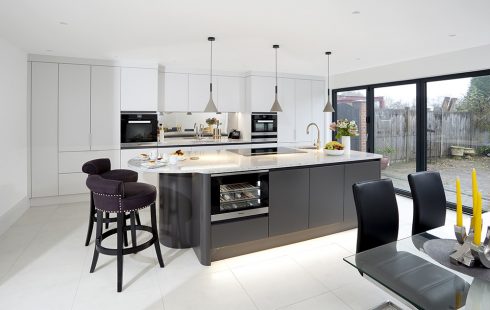
Anglia Factors team support breast cancer campaign with epic bike ride
Friday, 19th October was ‘Wear it Pink Day’ in aid of Breast Cancer Research UK, and Anglia Factors very own Dan, Claire and Alex Barr are...
Continue Reading
 More floor
More floorYour kitchen flooring is a big part of your bespoke kitchen. When you think about total surface area and the part of the kitchen that you come into contact with more than any other – it’s the floor. Even though you might spend a lot of time at your worktop or sink – it’s the flooring in hand-crafted kitchens that comes in for most contact.
So it’s important to get it right.
 Durability – it probably attracts more footfall than any other in your house
Durability – it probably attracts more footfall than any other in your house
Waterproofing – the kitchen is home to all sorts of liquids from tasty to caustic
Warmth – even if it’s periodically underfloor-heated it has to always be warm to bare feet
Softness – more chance that crockery will bounce it dropped on softer surfaces
Noise – even with fabrics kitchens can attract echoes
Cleaning – because bespoke kitchens are fundamentally food preparation areas
Non-slip – you’re handling crockery in a damp environment
Good value – 10-15% of your new kitchen budget?
Appearance – okay, it has to look good and this is the major criterion of CHOICE
So, a lot of kitchen floor options offer some of these qualities, some offer most of them. The main element that will determine your selection will be appearance.
 Wood – engineered or natural – quite durable, warm and looks good. Does have to be sealed.
Wood – engineered or natural – quite durable, warm and looks good. Does have to be sealed.
Ceramic Tiles – durable, waterproof, clean, can be good value and a wide variety of finishes
Stone/Brick – durable, waterproof, non-slip and looks great but again needs to be sealed
Vinyl/LVT Luxury Vinyl Tiles – tick all the boxes and the widest choice of appearance
Carpet/carpet tiles – quite durable, warm, quiet, non-slip and good value
Other – Rubber, cork, bamboo, polished concrete, resins and coir all have some merit
 Before considering the aesthetics; the material, colour, texture and design of your kitchen flooring you should consider objectively what sort of hand-crafted kitchen you want. Will it be an extension of the reception rooms of the house? A room that’s as likely to see gatherings of people as a living room or conservatory for example. Most modern kitchens are just this; a central family space used by everyone for a variety of reasons. you might also read our blogs on Handmade Kitchens, Kitchen Lighting and Kitchen Colours.
Before considering the aesthetics; the material, colour, texture and design of your kitchen flooring you should consider objectively what sort of hand-crafted kitchen you want. Will it be an extension of the reception rooms of the house? A room that’s as likely to see gatherings of people as a living room or conservatory for example. Most modern kitchens are just this; a central family space used by everyone for a variety of reasons. you might also read our blogs on Handmade Kitchens, Kitchen Lighting and Kitchen Colours.
Also consider your own use of the room. If you’re a keen cook, likely to spend hours in the kitchen standing at the chopping board or surfaces then you might consider a floor that’s kinder on the feet like vinyl, something that cushions the feet and has a bit of spring in it. This is especially the case if you have  young children who play on the floor and wander around barefoot. They will appreciate a warmer, softer finish that easy to keep spotless. This goes for animals as well – keeping your food preparation area clean is even more important when pets are involved.
young children who play on the floor and wander around barefoot. They will appreciate a warmer, softer finish that easy to keep spotless. This goes for animals as well – keeping your food preparation area clean is even more important when pets are involved.
Another important consideration, and often a prime determinant of choice, is geography. Where is the kitchen located within the house? These days we see many bespoke kitchens requiring small building works to open an adjacent space onto a garden, patio or conservatory that leads to outside. With adults, children and animals moving back and forth between the garden and the kitchen you will require a floor that’s durable, easy to clean and doesn’t show marks.
Don’t forget to insert mats that are countersunk into the floor for added integrated cleanliness.
 We have noticed a marked increase in the number of bespoke kitchens in Suffolk where we have installed underfloor heating. Most kitchen flooring coverings can be used with underfloor heating, but some are better than others.
We have noticed a marked increase in the number of bespoke kitchens in Suffolk where we have installed underfloor heating. Most kitchen flooring coverings can be used with underfloor heating, but some are better than others.
The best are traditional hard floors like stone, ceramic or porcelain tiles. The material is very thermally conductive especially if the tiles are thin – so the heating gets transferred to the flooring efficiently with no leakage and the floor makes the kitchen warm from the ground up. With tiles you do have to lay a de-coupling membrane with flexible adhesive to stop drying out cracks breaking the tiles. Polished concrete and synthetic resin floors also benefit from underfloor heating as they can be stark and warming them up makes them much more welcoming and homely.
After tiles engineered wood & laminates like vinyl are pretty good at transferring heat without warping. Engineered wood in particular can be laid directly ‘floating’ on underfloor heating or fixed discretely to joists or battens. Other woods like softwoods and hardwoods can also transfer heat but professional advice should be sought on the depth and breadth of boards.
As for carpets and carpet tiles, as long as the underlay doesn’t act as a thermal insulator (no more than 1 tog) and the carpet itself is less than 2.5 togs warmth can pass easily through the carpet. Underlays like polyurethane and felt shouldn’t be used as you’re effectively insulating your heat source.
With vinyl floors (and vinyl tiles, lino etc) you can lay them on heated floors but you have to be careful the floor doesn’t get too hot as that will discolour the floor covering.
 Assuming your kitchen is on a ground floor its floor will probably be made from a concrete slab or suspended block and beam if it’s a young building. Older houses can still have floorboards and it is popular to renovate these as an attractive original feature.
Assuming your kitchen is on a ground floor its floor will probably be made from a concrete slab or suspended block and beam if it’s a young building. Older houses can still have floorboards and it is popular to renovate these as an attractive original feature.
With a kitchen, where you will need services at various places within the room, consider where you’re placing sinks, appliances and cookers so you can plan where you run cables and pipes through your floor – will you have a sink in your island for instance? With a concrete floor this has to be ducted at the point of pouring. Timber floor joists can be drilled or adapted and modern I-joists and similar developments which are far easier to run services through than traditional timber joists.
Another reason that you have to select your kitchen flooring very early in the kitchen planning process is that it sets the floor levels from which many other elements like ceiling height, door thresholds and staircases are set.
 Don’t forget that Building Regulations require that ground floors should be insulated while adding extra expense it is a common sense move that can save you money on heating and, if you’ve elected for underfloor heating, makes sure warmth is directed to the right place.
Don’t forget that Building Regulations require that ground floors should be insulated while adding extra expense it is a common sense move that can save you money on heating and, if you’ve elected for underfloor heating, makes sure warmth is directed to the right place.
The key messages that come through this consideration of kitchen flooring options are: –
1. There is a wide choice of kitchen flooring
2. Some floors will suit your style better than others
3. Your choice of floor should be made early in the kitchen planning process
4. Consult a professional, like ourselves, early on.

Anglia Factors team support breast cancer campaign with epic bike ride
Friday, 19th October was ‘Wear it Pink Day’ in aid of Breast Cancer Research UK, and Anglia Factors very own Dan, Claire and Alex Barr are...
Continue Reading

Top kitchen trends for 2019
Are you in a new year, new kitchen frame of mind? Has all the wear and tear of Christmas made you realise it’s time to make that redesign happen?...
Continue Reading